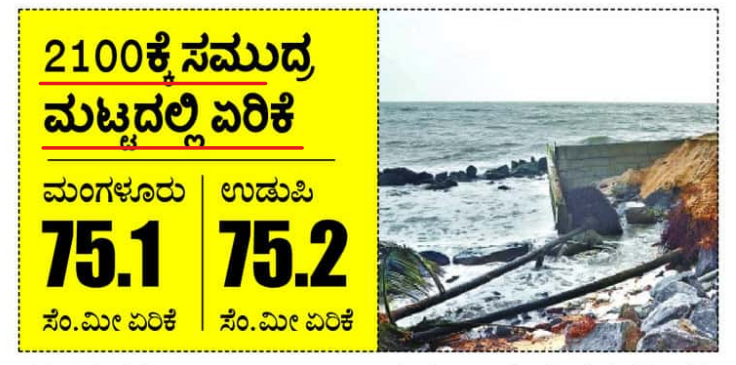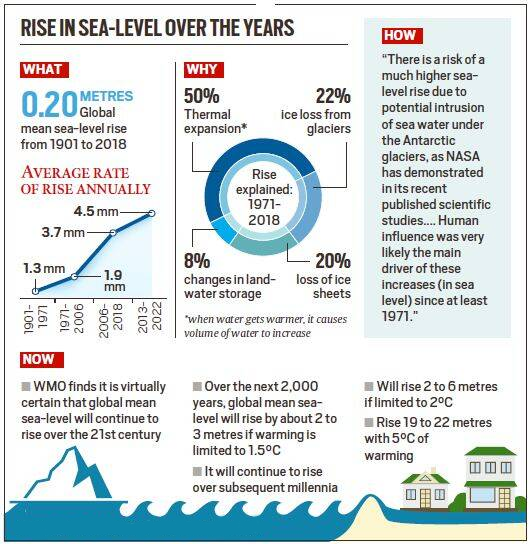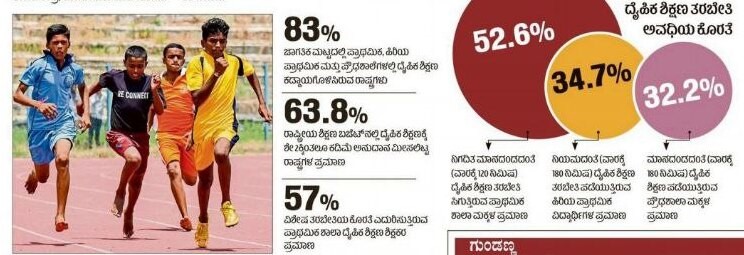1.Mangalore, Udupi 5% land to sea by 2040!
Context:
- A recent report from the Bangalore-based think tank, Center for Study of Sciences, highlights the alarming impact of rising sea levels on coastal cities in Karnataka, including Mangalore and Udupi.
- The report warns that these areas will face significant land loss due to natural disasters and sea level rise.
Mangalore, Udupi:
- The rise in sea level due to climate change effects will cover 5% of the land area of Mangalore and Udupi.
- Similarly, coastal cities such as Mumbai, Kochi, Visakhapatnam, Puri, Chennai, Thiruvananthapuram, Kallikote, Haldia, Kanyakumari, Panaji, Paradeep, Thoothukudi and Yanam will also face the problem, the report warned.
Big shock for 3 cities:
- Compared to the rest of the coastal cities, Mumbai, the commercial capital of the country, Yanam to Pondicherry and Thoothukudi in Tamil Nadu are likely to lose more than 10% of their land area.
- The report warns that Panaji and Chennai are likely to lose 5% to 10%, while other cities are likely to lose 1% to 5%.
Global Sea-level Rise and Implications: WMO
- According to theWorld Meteorological Organisation ‘s (WMO) Report “Global Sea-level Rise and Implications”, India, China, Bangladesh and the Netherlands face the highest threat of sea-level rise
- These include Shanghai, Dhaka, Bangkok, Jakarta, Mumbai, Maputo, Lagos, Cairo, London, Copenhagen, New York, Los Angeles, Buenos Aires and Santiago.
What are the Highlights of the Report?
- Between 2013 and 2022, Global mean sea-level was 5 mm/year and human influencewas likely the main driver of these increases since at least 1971.
- Global mean sea-level increased by 20m between 1901 and 2018,
- 3 mm/ year between 1901 and 1971,
- 9 mm/year between 1971 and 2006
- 7 mm/year between 2006 and 2018.
- Even if global heating is limited to 5 degrees Celsius over pre-industrial levels, there will still be a sizable sea level rise.
- But every fraction of a degree counts. If temperatures rise by 2 degrees, that level rise could double, with further temperature increases bringing exponential sea level increases.
What is the Scenario for India?
- According to the Ministry of Earth Sciences, on average, the sea level along the Indian coast was observed to be rising at a rate of about 7 mm/year during the last century (1900-2000).
- A 3 cm sea level rise could cause the sea to intrude inland by about 17 meters. At future rates of 5 cm/decade, this could be 300 metres of land taken by the sea in a century.
2.Karnataka to triple the size of its BioEconomy to $100 bn by 2030
Context:
- Karnataka has an ambitious mandate to more than triple the size of its BioEconomy to $100 billion by 2030, from $31 billion in 2023, growing 7% from $28 billion in the previous year.
- BioEconomy currently contributes 10%-12% of Karnataka’s Economy of $310 billion.
- The state, being the leader in biotech, attracted over 30% of national biotech investments in 2023, contributing 21% to India’s BioEconomy.
- According to the Karnataka BioEconomy Report 2024 unveiled here on Wednesday,
- The State will focus on growing BioPhar ma contributions to $30 billion, expanding BioAgri to $15 billion, and quadrupling BioIndustrial contributions to $30 billion to achieve its $100 billion target in next six years
What is bioeconomy in simple words?
- The bioeconomy is the knowledge-based production and use of biological resources to provide products, processes and services in all economic sectors within the frame of a sustainable economic system.
Examples:
- Food systems occupy the largest niche in the bioeconomy. To these systems, which include
- Sustainable agriculture,
- Sustainable Fishing,
- Forestry and aquaculture,
- Food and feed manufacturing,
Bio-Based Products:
- Bioplastics,
- Biodegradable clothing.
Key Highlights
- India’s bioeconomy is likely totouch USD 150 billion by 2025 and over USD 300 billion by 2030.
- The country’s bioeconomy has reached over USD 80 billion in 2021, registering a 1 percent growth over USD 70.2 billion in 2020.
- On average, at least three biotech startups were incorporated every day in 2021 (a total of 1,128 biotech startups set up in 2021)and the industry crossed USD 1 billion in research and development spending.
- India has the second highest number of USFDA-approved manufacturing plants outside the US.
3.A mirage for school children
Context:
- Play is recognized as a crucial component of education, significantly contributing to both the physical and mental development of children.
- Qualitative Physical Education” (QPE) released by the United Nations Educational, Scientific and Cultural Organization (UNESCO) highlights that many schools globally do not prioritize play with the same emphasis as academic lessons.
- UNESCO aims to align physical education with the broader educational goals of promoting comprehensive development and well-being among children
Recommendations:
- Every country should implement effective policies regarding physical education.
- Lack of physical education infrastructure in many countries due to insufficient funding. More funds should be earmarked for providing all the facilities.
- Qualified and expert teachers should be recruited. Training should be provided for their skill development.
- Equal opportunities should be given to girls and disabled individuals, just as they are to boys, in physical education.
- Action should be taken to further improve the physical education curriculum. A study and research-based curriculum should be implemented.
Schemes to Promote Sports:
- Sports Authority of India (Ministry of Youth Affairs & Sports)
- Khelo India Scheme
- Assistance to National Sports Federations;
- Special Awards to Winners in International sports events and their Coaches;
- National Sports Awards, Pension to Meritorious Sports Persons;
- Pandit Deendayal Upadhyay National Sports Welfare Fund;
- National Sports Development Fund; and
- Running Sports Training Centers through Sports Authority of India.







